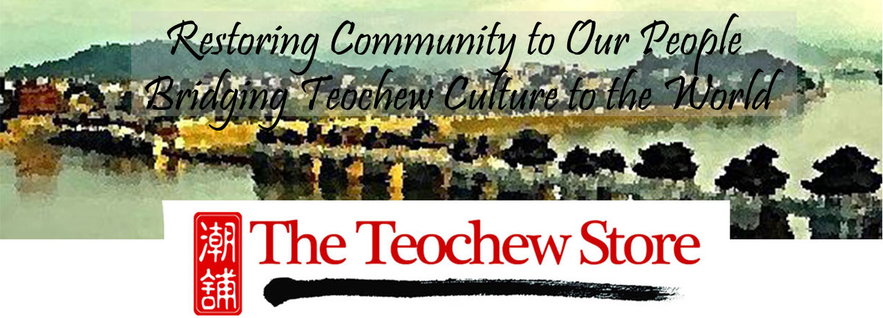Visiting the Teochew region in China to “re-discover” one’s roots has become increasingly popular in recent years amongst overseas Teochews. Quite reasonably we arrive expecting our ancestral heritage to be perfectly preserved in motherland, only to find that the Teochews here no longer call the place Teochew, but Teo-Swa (潮汕, in Mandarin: Chaoshan) and themselves Teo-Swa Nang (潮汕人, Chaoshan-ren). Baffled, if not also shocked, we question how can this be?
To make sense of this, we first need to know Teo-Swa is simply the contraction of the names of the two largest Teochew urban centres Teochew (潮州, Chaozhou; also referred by the elderly as Hu-sia 府城, the prefectural capital) and Swatow (汕頭, Shantou). Teochew, the oldest city in the Teochew region is said to be founded in circa 331. It was given its name during the Sui dynasty in 592 when it became the centre of a prefecture with the same designation. Literally meaning the “Tidal Prefecture”, the term Teochew is said to be inspired by the eternal flow and ebb of the South China Sea and it reflected the importance of the settlement as a trading port.

Map showing route of the Chao Chow-Swatow- railway line in 1908
As the result of extensive human reclamation to create agricultural land, the delta area of the Hangkang (韓江 Han River) by which Teochew city lay extended southwards significantly through the centuries. By the time of late imperial China the region needed to be served by a new port closer to the sea, and this role was taken up by a succession of coastal towns such as Tsia-lim 柘林 and Changlim樟林. However none of them prospered for long, for like Teochew, their harbour areas were eventually silted up by river sediments. Finally following the Second Opium War, Swatow, hitherto a nondescript fishing village, was forced open by the Americans to become a Treaty Port in 1860. Boosted by its ideal location by the sea and at the intersection of the mouths of Hangkang and another major waterway Iongkang (榕江 Rong River, which leads to another the city of Gek-yor 揭陽), as well as an inflow of capital from Teochew diaspora communities established in major trading centres across the South China Sea, such as Bangkok, Singapore and Saigon, Swatow flourished rapidly.
By the early 1900s Swatow was emerging as a hub for new wealth, as opposed to Teochew where the old landowning literati class held sway. This supported the proposal of a consortium of Chinese businessmen to build a railway line running parallel to the Hangkang. After two years of construction undertaken by Japanese contractors, the Chao Chow and Swatow Railway began operations in November 1906. And it was from its shortened Chinese name潮汕铁路 (Chao-Swa Railway, or in Teochew: Teo-Swa Railway) that the expression “Teo-Swa” was born.

Japanese soldiers in 1939 marching past an abandoned locomotive marked with Teo-Swa 潮汕
The Chao Chow and Swatow Railway operated for 33 long years until Swatow was invaded by Japanese in June 1939 and the Kuomintang government ordered its dismantle for strategic reasons. However in the three decades in-between Swatow had grown from being a satellite of Teochew to the third largest port in China (trailing behind only Shanghai and Guangzhou in scale of commerce) and a city recognised on its own right. Inevitably the term “Teo-Swa” resurfaced ten years later after the Chinese Communist Party came into power and re-organised the historical Teochew prefecture into the Teo-Swa Special Area (潮汕专区). A series of subsequent administrative re-alignments and the declaration of Swatow as a special economic zone in 1980, left Teochew in the shadow of its upstart rival. Gradually as the locals associated “Teochew” with only the old capital city and its immediate vicinity, Teo-Swa became in the context of mainland China the name of the territory and its population.

The newly completed Teo-Swa/Chaoshan High-speed Train Station, located near Teochew city.
For the “purists” amongst us, Teo-Swa is an alien, and even a divisive term. After all Teochew Nang-Gaginang, the Teochew identity is what unites and defines us. Moreover the term Teochew has been in use for more than 1,400 years, as compared to Teo-Swa that has been wider use for merely over half a century. Still the application of “Teo-Swa” is already entrenched in mainland China and there is no immediate solution to the problem. But we can at least acknowledge that it is the result of the isolation of the Teochews in China and abroad in the past, and not allow it to divide us by seeking to understand and know our fellow Teochews regardless of where we live.
~o0o~
You may be interested in reading also
"Like" our Facebook page to stay updated with The Teochew Store.
